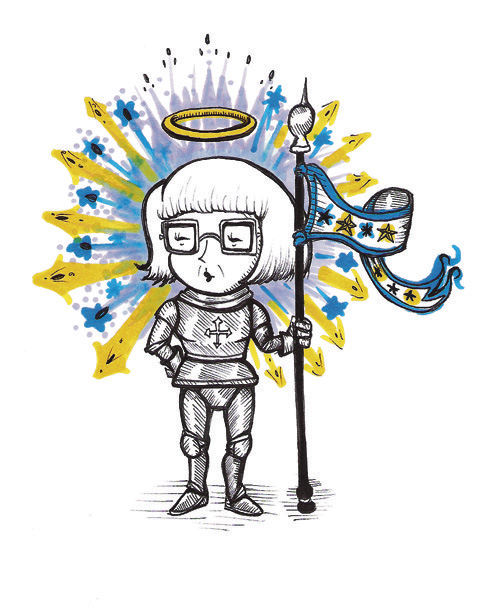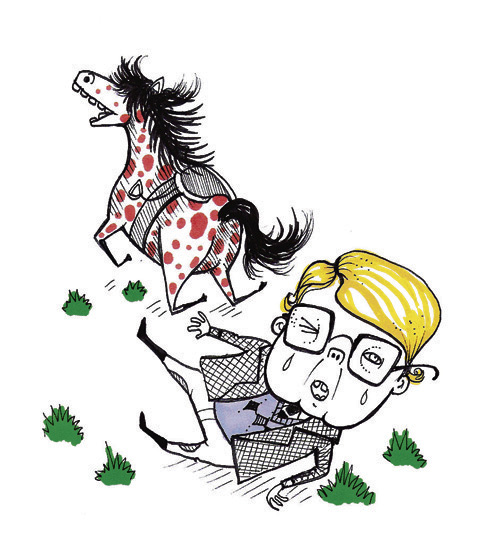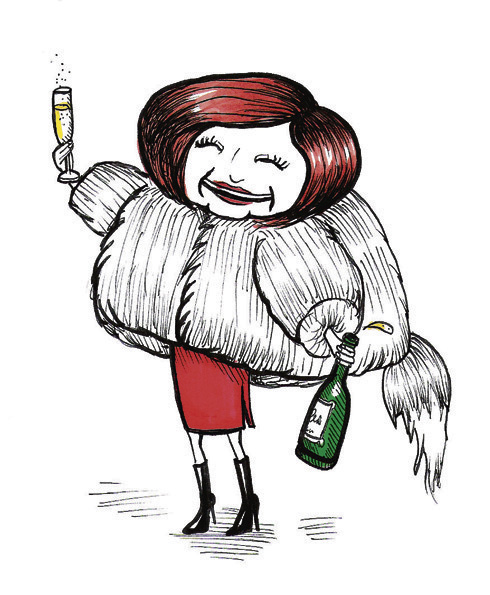Noted political and social commentator Egill Helgason has hosted Iceland’s main political debate Show, Silfur Egils (now showing on RÚV, alongside his literary program Kiljan) for many years. Through his shows and his blog on local news aggregator Eyjan.is, he is undoubtedly a major influence on Icelandic discourse and is known for his sharp, often hard-hitting analyses of current affairs – especially in the aftermath of October 2008’s economic collapse.
For the next months, Egill Helgason will be writing us a column detailing his take on and interpretation of the preceding month’s events. The Grapevine is proud and happy to welcome Egill as a contributor to the paper. We feel his insights will prove an exemplary contribution for international audiences and new Icelanders that are interested in following the local discourse on a deeper level.
Read RIGHT ON for his extended introductory column, which should tell you some things about 2009, in the spirit of this issue.
Later this month we will see the one-year anniversary of the pots and pans revolution that shook Reykjavík in January of last year. This miniature revolution started peacefully, with people banging saucepans and cooking pots, but ended in street riots, fires and teargas.
As is often the case with revolutions, it was a small incident that sparked the events.
Parliament was reconvening after Christmas. Everybody expected it to make a major effort on the crisis. But the government of conservative Prime Minister Geir Haarde was as ever disconnected from the populace—now we even have the verb of “Haardering” in the Icelandic language, meaning basically to keep your head in a pile of sand—so the parliament started the new year by discussing a bill proposed by a young and rather silly politician of Haarde’s party, calling for alcohol to be sold in supermarkets.
Maybe a large issue for some, but by most this was perceived as being a symbol of how far the political class had alienated itself from reality and, with a peculiar mixture of liberalism and cronyism, handed power to cliques of bankers and financiers, many of them originating in the grey zone between politics and business.
Icelanders, a nation more given to grumbling than manning the barricades, were suddenly out in force, expressing their total discontent with a political system that had led the nation down the way of ruin. The highpoint of these events, just a year ago, was the burning of a huge Christmas tree, given to Reykjavik annually by the city of Oslo as a token of goodwill.
As the tree went up in flames, the police brought out their teargas canisters—a turn of events unheard of in Iceland.
— — —
In Iceland it is referred to as a revolution—”bylting” is the Icelandic word. It surely toppled the government of Geir Haarde, which drifted with all senses shut into the collapse of October 2008, all the time claiming that the problem was rather one of image—a misunderstanding of the Icelandic economy—than substance. “Incompetent government” was a popular slogan during these days.
The Social Democrats, a junior party that had entered the coalition government with Haarde’s Independence Party in 2007—The Independence Party having led the government ever since 1991—took fright after a party meeting in the basement of the National Theatre was literally mobbed one night. The Social Democrats then proceeded to form a government with the socialist/environmental Left Green party, which actually can trace some of its origins all the way back to the Icelandic Communist party that formed in 1930.

This is, at least on paper, the most left wing government in Icelandic history, referring to itself as a government of Nordic Welfare. The Prime Minister is Jóhanna Sigurðardóttir—often referred to as Holy Jóhanna—chosen at the time of the pots and pans revolution because she is thought to be incorruptible and is also a figurehead of welfare politics. But it soon transpired that the strong man of the government, the real fighter, is Steingrímur J. Sigfússon, Minister of Finance, the leader of the Left Greens, a prematurely bald country boy who entered parliament at a very young age in 1983. Sigfússon has spent most of his political life as a member of the opposition and many were waiting for him to retire—as is also the fact with Jóhanna Sigurðardóttir.
But then, by this strange turn of events, he is now in the position of the most influential man in the government, the man who is everywhere, doing the fighting, putting out the fires, cleaning up the mess, earning grudging respect, but not necessarily becoming more popular.
— — —
 Maybe the government’s chosen slogan isn’t good enough. It is very difficult to dole out Nordic Welfare in a country that is almost bankrupt. The government has in fact seen no other option but to follow the prescriptions of the International Monetary Fund to the letter, in fact it shares its power with the IMF governors. Many of the hardest left-wingers in government have been forced to change their ways; they have even accepted an application to join the European Union, total anathema to the Left Greens until recently. And most of the party has been forced to campaign for the acceptance of Icesave, the reimbursement by Icelandic taxpayers of money lost through savings accounts in several European countries.
Maybe the government’s chosen slogan isn’t good enough. It is very difficult to dole out Nordic Welfare in a country that is almost bankrupt. The government has in fact seen no other option but to follow the prescriptions of the International Monetary Fund to the letter, in fact it shares its power with the IMF governors. Many of the hardest left-wingers in government have been forced to change their ways; they have even accepted an application to join the European Union, total anathema to the Left Greens until recently. And most of the party has been forced to campaign for the acceptance of Icesave, the reimbursement by Icelandic taxpayers of money lost through savings accounts in several European countries.
“Cleaning up the mess,” is a phrase that Sigfússon uses frequently.
A revolution devours its children. This can be said of the government that came into power through the pots and pans revolution, which seemed full of promise for a few months last year but now looks weak and full of contradictions. It has three major problems it has not managed to tackle:
1. The terrible household debt, aggravated by the total collapse of the currency, lowering of housing prices and the strange Icelandic phenomenon of loans being indexed to the rampant inflation (while pay and savings are not).
2. The question of what to do with the companies that have fallen into the hands of the government and the banks. Included are many of the nation’s major companies, as well as the large holding companies that owned practically everything at the time of the boom. All the latter companies are now bankrupt, with a horrible ratio of debt.
How do you redistribute the wealth of a society that has collapsed? Even the fishing industry, once again the pillar of the economy, is riddled with debt, brought on by speculation with fishing quotas where huge sums have disappeared into offshore accounts.
Despite its left-wing credentials the government seems to be set on doing this in a very old guardish way, through the partially restructured banks—now nominally in the hands of foreign creditors—but in reality run by Icelandic lawyers and economists, many of whom are linked to the former elite, which was the problem in the first place.

The most famous instance is Jón Ásgeir Jóhannesson of Baugur fame, who in the heyday of the Icelandic ‘venture Vikings’ owned many famous brands on the high streets of London. But this was built on his empire of supermarkets in Iceland, which his family still has control of. Jón Ásgeir´s total debt is thought to be about 1.000 billion ISK; he is surely one of those who bankrupted the nation, but there is talk that he might hold on to his supermarkets if he manages to negotiate his debt, which is only a fraction of the mess he has left behind.
And, to add insult to injury, Jón Ásgeir still controls most of the privately owned media in Iceland.
3. Icesave… This is a word that spells dread—and perhaps boredom—into the hearts of Icelanders. Icesave has now been furiously debated for more than a year. Originally this is the moniker—thought brilliant at the time—of savings accounts founded by Icelandic bank Landsbanki in the UK, Holland and Belgium. At the time foreigners had almost stopped lending money to the Icelandic banks, so they devised a scheme: we will offer fabulous interest rates, and we will be able to fund ourselves by the money flowing in.
Except there was no backup plan. If the Icelandic bank went bankrupt, there was nobody to guarantee the deposits. The Icelandic insurance fund was empty. And one day Icesave just closed down, its web pages disappeared; at the Icesave offices no one answered the phone. It was, in short, a scam.
Our neighbouring countries—even our friendly Nordic neighbours—soon decided that it was up to Icelanders, our government and taxpayers, to reimburse the holders of these savings accounts, individuals, municipalities, charities, up to a certain sum. Maybe this is not unfair. But the sum of money is so vast compared to the Icelandic economy that this might even spell doom for the recovery of the country, which, though proud and enterprising, has the population of Wichita, Cardiff or Murmansk.
— — —
Icesave has dominated local political life since the collapse. For Icelanders this has turned into a nightmare, the feeling is a bit like in the film The Exterminating Angel by Luis Bunuel, where a group of people are stuck in a room without really understanding why they cannot get out.
Shortly before New Year, Parliament passed a bill saying we should pay. This was the second bill, now referred to as Icesave 2, the first one having been declined by the British and the Dutch. At the time of writing, the nation had just learned that President Ólafur Ragnar Grímsson declined signing the bill – thereby effectively vetoing it and subjecting it to a national referendum.

As Grímsson pondered his move, he must surely have looked into the burden of debt, to the constitutional ramifications of his signature, but also to his own legacy. Grímsson, a real political animal who used to be the chairman of the socialist People’s Alliance up to the early nineties, has managed to become the only president in the history of the Icelandic republic who is actively unpopular and a figure of ridicule. Many of his sayings during the boom years are now a source of embarrassment and he and his wife, wealthy socialite Dorrit Moussaief, are said to have become groupies of the financiers, the so-called ‘venture Vikings’.
Indeed, shortly after news of his veto (and subsequent news of harsh reactions by Dutch and UK governments), loud and strongly worded calls for his resignation had already started echoing through local discourse.
Grímsson’s veto might spell the end of the present left-wing government—ironically, as he comes from the left wing himself—but it might also turn into a constitutional crisis as Icesave goes back and forth from the government, to the parliament and then to the president, hitherto a symbolic figure in the vein of the Scandinavian monarchs in their Lego palaces.
— — —
The moment of truth should come on February 1st, when a special committee, appointed by Alþingi, will deliver a 1.500 page report on the collapse. The members of the committee are still held in a measure of respect by the public, but it must be noted that two of them are also members of the old guard: one being the parliamentary ombudsman, the other a judge of the High Court who, as a law professor, used to do a lot of work for the former government. The third is a relatively unknown Harvard-trained economist.
The chairman of the committee was quoted last year as saying that he would have seriously bad news for the population. Even so, many dread that the findings will be, maybe not a whitewash, but that they will be so muddled as to be an endless source of interpretation, strife and spin.
Those who have most to lose from the report have already organised themselves. In one of the most bizarre twists Icelandic politics has seen, former PM, former Central Bank manger, the force behind the privatisation of the Icelandic bank system—and, some say, architect of the collapse itself, Davíð Oddsson—was made editor of Morgunblaðið, formerly the most prestigious newspaper in the country.

In a matter of weeks the paper turned into a vehicle for Oddsson and his cronies, the subscribers disappeared in droves and now little remains of the old prestige. This is not only a battle for political power, but also for what will be written in the history books.
— — —
What then about the legacy of the pots and pans revolution?
In a way, it reminds one of T.E. Lawrence, who in the early pages of The Seven Pillars of Wisdom talks about the fate of his own revolt in the desert. The old guys came back and stole the revolution. After the burning of the Oslo Christmas tree things quickly fell back into place. Parliamentary elections were held, and the old political parties—the ‘four parties’ as they are called in Iceland—basically held out. We got a left-wing government but it is not doing things very differently from what the old government would do. Iceland is subject to a strict IMF program; most of the government’s moves are forced.
Icesave has yet to boil into riots. Up until now the protests in front of parliament have been muted; the strongest sign of protest being a list of signatures against Icesave 2 with a sizable part of the electorate putting their names on it. Taxes have been raised on the better off—very few people are really rich in post-collapse Iceland—so we might yet see the upper classes coming down to rattle their jewellery down in Austurvöllur square, in front of Alþingi.
This doesn’t seem likely, though. For now, the nation seems rather settled in its grumbling ways; a cloud of depression and discontent hovers over the country. But mood changes can be swift in this Nordic place where the arctic night now holds the reins. This is a great change from the silly euphoria of the boom years, with all its imagined victories on the stage of global finance. Many now say that the best we can do is to keep on fishing and churning out aluminium from our smelters; that this is a good enough vision for the future. Even the IMF talks about Iceland being a production economy for a long time, while debts are being paid.
But, it has to be admitted, that for the young people of this country this seems to be a rather gloomy outlook.
- Illustrations Lóa Hlín Hjálmtýsdóttir
Buy subscriptions, t-shirts and more from our shop right here!















